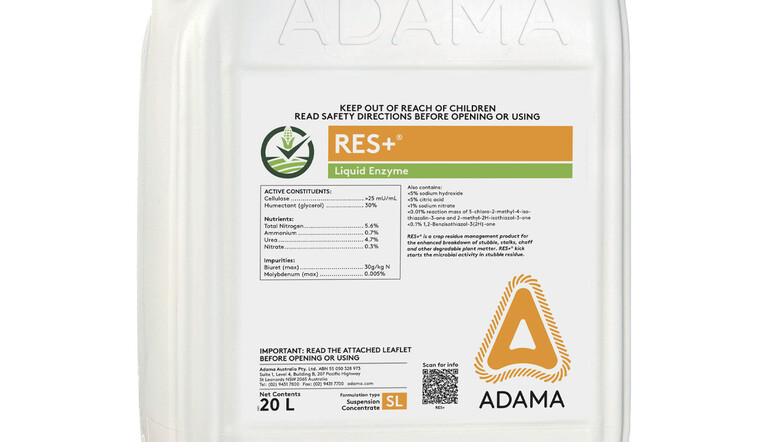
ADAMA adds unique stubble management solution for multiple cropping benefits

GROWING crop protection formulation specialist and supplier, ADAMA Australia, is excited to strengthen its early season portfolio with a new product addressing a key challenge many growers face prior to planting – crop stubble management.
In an extension of its partnership with leading US life sciences company, Elemental Enzymes, ADAMA will now exclusively offer RES+, a powerful residue management tool, to the country’s growers.
Looking ahead, ADAMA and Elemental Enzymes plan to launch several new products including a ground-breaking biological fungicide to target the growing foliar disease threat in broadacre crops. Powered by Elemental Enzymes’ patented peptide technology, the new biofungicide will deliver a novel mode of action for disease control.
Unlike conventional or live microbial stubble digesters, RES+ features a residue-degrading enzyme (cellulase), chelated nutrients to boost microbial activity, and a humectant to retain moisture – accelerating residue breakdown even under low-moisture conditions
Elemental Enzymes Technical Development Manager Chad Sayer said RES+ was a breakthrough that was especially well-suited to Australian conditions.
“Enzymes are more robust and efficient – this is a world first approach for residue management,” Chad said.
Andrew Newall, ADAMA Australia’s General Manager - Portfolio and Innovation, said RES+ would bring a distinct advantage to the market segment and reflected the company’s ongoing collaboration with Elemental Enzymes.
“With the development of no-till farming and stubble retention increasing over the past two decades, and particularly the higher stubble loads in recent seasons, residue management is high on the agenda for the industry and growers,” Andrew said.
“RES+ can be applied well before planting – during summer or with fallow herbicide applications – kick-starting residue breakdown and easing stubble handling at sowing.
“Stubble management is front-of-mind with seeding recently completed and the beauty of this product is you can apply it well before seeding with summer and fallow sprays. You can add RES+ with these sprays to start the stubble breakdown, allowing for improved stubble handling at planting.
“Rather than relying on high humidity and moisture for high microbial activity with other digesters, the enzyme base with RES+ allows the breakdown to happen with very low moisture and the humectant helps keep the enzyme active.”
He said demonstrations and sales for this season were very positive in Western Australia, Victoria and Queensland, and while some early activity had been queried, the excellent breakdown was well recognised prior to seeding.
Elemental Enzymes Australia Director Guy Perriman said RES+ was a great alternative to stubble burning, providing enhanced productivity through nutrient cycling, in addition to allowing easier sowing conditions.
“Growers can get the nutritional benefits of the stubble breakdown whilst making it easier for planting, and also still achieve protection for emerging seedlings,” Guy said.
Applied following harvest up until planting, RES+ has achieved excellent results on winter cereal, canola and legume stubbles, as well as ahead of cotton, sorghum and cane plantings.
In a long-term wheat-on-wheat site at Katanning in Western Australia, applications before sowing consistently achieved 5-7pc yield gains annually over four years.
“One of the best results also was on the Darling Downs in Queensland on a sorghum stubble cover crop. The following broccoli crop recorded an extra $5400 per hectare yield increase,” Guy said.
He said ADAMA Australia had a strong track record of local development and bringing new technologies to Australian growers, and Elemental Enzymes was excited to work with the business and its well-respected team across the country.
Chad said ADAMA Australia had great reach into broadacre farming regions and the two organisations were closely aligned on the wider benefits and future potential with RES+.
“It will help growers to maintain their stubbles and, importantly, allow them to get through seeding programs with their machinery in an improved manner.”
“There are nutrient benefits from the stubble that also flow through to subsequent crops and there are implications for disease control by helping mitigate it in stubbles,” he said.
For further information on the RES+ stubble digester, growers and agronomists can contact their local ADAMA Australia representative or visit ADAMA.com.
Media Contact:
Andrew Newall |General Manager Portfolio & Innovation| D: 0418 224 422 |
E: andrew.newall@adama.com